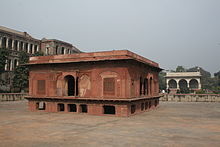Hayat Bakhsh Bagh: Difference between revisions
m Checkwiki + General Fixes using AWB |
Gryffindor (talk | contribs) No edit summary |
||
| Line 1: | Line 1: | ||
[[File:Fuerte Rojo-Delhi-India69.JPG|thumb|The red ''Zafar Mahal'' and the white ''Sawan/Bhadon'' pavilion behind it]] |
[[File:Fuerte Rojo-Delhi-India69.JPG|thumb|The red ''Zafar Mahal'' and the white ''Sawan/Bhadon'' pavilion behind it]] |
||
[[File:Sawan Pavillion, Red Fort.jpg|thumb|One of the ''Sawan/Bhadon'' pavilions]] |
[[File:Sawan Pavillion, Red Fort.jpg|thumb|One of the ''Sawan/Bhadon'' pavilions]] |
||
The '''''Hayat Baksh Bagh''''' |
The '''''Hayat Baksh Bagh''''', which means "Life-bestowing garden", is the largest of the gardens in the [[Red Fort]] in Delhi. |
||
It was laid out by Shah Jahan I. The garden was largely destroyed by the British colonial forces following the failed 1857 rebellion. Most of the garden was built over by stone barracks by the British colonialists after 1857. |
It was laid out by Shah Jahan I. It had the size of around 200 square feet.<ref>http://www.archive.org/stream/handbooktravelle00john#page/196</ref> The garden was largely destroyed by the British colonial forces following the failed 1857 rebellion. Most of the garden was built over by stone barracks by the British colonialists after 1857. [[Lord Curzon]] has some elements of the garden restored.<ref>http://www.archive.org/stream/handbooktravelle00john#page/196</ref> |
||
The garden is divided into four squares, with causeways, water channels and a star-shaped parterre framed with red sandstone. Originally, flowers in blue, white and purple were planted throughout. |
The garden is divided into four squares, with causeways, water channels and a star-shaped parterre framed with red sandstone. Originally, flowers in blue, white and purple were planted throughout. |
||
| Line 12: | Line 12: | ||
In the middle between the two pavilions lies the ''Zafar Mahal''. This structure was constructed during the reign of [[Bahadur Shah II]] in 1842 and named after him. This pavilion stands in the middle of a pre-existing water tank. It is made out of red sandstone, which was cheaper than white marble. After the occupation in 1857, the tank was used as a swimming pool by the British troops.<ref name="ASI"/> |
In the middle between the two pavilions lies the ''Zafar Mahal''. This structure was constructed during the reign of [[Bahadur Shah II]] in 1842 and named after him. This pavilion stands in the middle of a pre-existing water tank. It is made out of red sandstone, which was cheaper than white marble. After the occupation in 1857, the tank was used as a swimming pool by the British troops.<ref name="ASI"/> |
||
West of the garden was another one called ''Mehtab Bagh'', or the "moon garden". Near the northwest corner is a ''[[baoli]]'' tank. The road from the ''baoli'' leads due south to the Delhi Gate of the fort.<ref>http://www.archive.org/stream/handbooktravelle00john#page/196</ref> |
|||
== References == |
== References == |
||
Revision as of 23:42, 25 December 2013


The Hayat Baksh Bagh, which means "Life-bestowing garden", is the largest of the gardens in the Red Fort in Delhi.
It was laid out by Shah Jahan I. It had the size of around 200 square feet.[1] The garden was largely destroyed by the British colonial forces following the failed 1857 rebellion. Most of the garden was built over by stone barracks by the British colonialists after 1857. Lord Curzon has some elements of the garden restored.[2]
The garden is divided into four squares, with causeways, water channels and a star-shaped parterre framed with red sandstone. Originally, flowers in blue, white and purple were planted throughout.
Three structures have survived from the time:
The Sawan and Bhadon pavilions (mandap) are two almost identical structures facing on opposite ends of the canal. They are carved out of white marble. A feature is a section of a wall with niches. Originally small oil lamps would be lit and placed in these niches at night, or vases with golden flowers be placed during the day. The water from the channel would cascade over it, creating the impression of a golden curtain. The names Sawan and Bhadon are the two rainy months in the Hindu calendar during the monsoon. It is not clear however which pavilion carries which name.[3]
In the middle between the two pavilions lies the Zafar Mahal. This structure was constructed during the reign of Bahadur Shah II in 1842 and named after him. This pavilion stands in the middle of a pre-existing water tank. It is made out of red sandstone, which was cheaper than white marble. After the occupation in 1857, the tank was used as a swimming pool by the British troops.[3]
West of the garden was another one called Mehtab Bagh, or the "moon garden". Near the northwest corner is a baoli tank. The road from the baoli leads due south to the Delhi Gate of the fort.[4]
References
External links
![]() Media related to Hayat Bakhsh Bagh (Red Fort) at Wikimedia Commons
Media related to Hayat Bakhsh Bagh (Red Fort) at Wikimedia Commons
